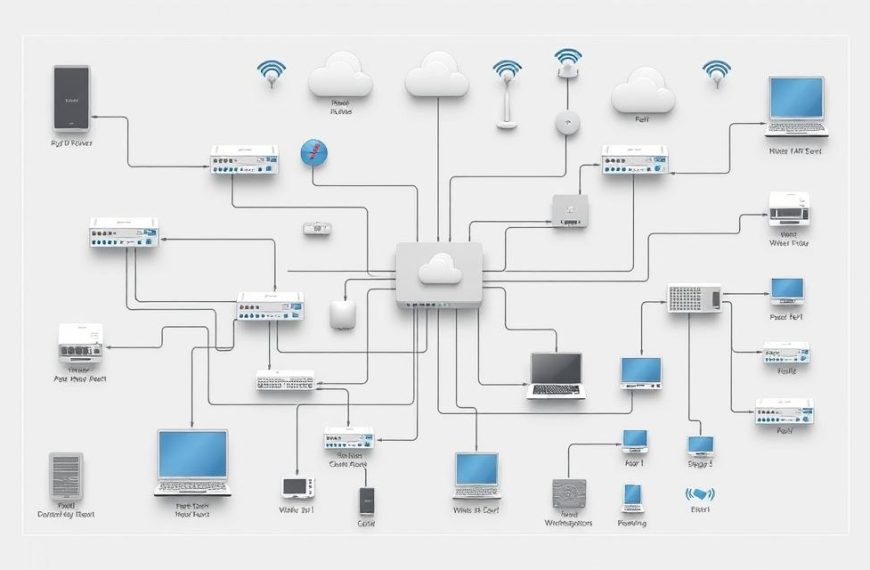Artificial intelligence continues to reshape industries, offering new capabilities and opportunities. From automating tasks to delivering actionable insights, this technology is transforming how companies operate. However, it’s essential to understand both its potential and limitations.
Recent advancements like ChatGPT and Google Bard highlight the rapid evolution of AI. Yet, adoption varies widely across sectors. For example, 52% of U.S. financial firms now use AI for stock trading, while others lag behind. This disparity underscores the importance of strategic implementation.
Organizations must also navigate ethical concerns and technical challenges. While AI can enhance decision-making and personalization, it’s not a one-size-fits-all solution. Success depends on aligning intelligence with organizational goals and addressing potential biases.
By focusing on practical applications and ethical considerations, businesses can leverage AI as a competitive advantage. The key lies in balancing innovation with real-world constraints.
Introduction to AI in Business
The rapid evolution of artificial intelligence has become a cornerstone of modern business strategies. From basic algorithms to deep neural networks, this technology has advanced significantly. Early adopters report a 45% increase in productivity, according to McKinsey.
Artificial intelligence operates through two primary models: supervised and unsupervised learning. Supervised learning relies on labeled data, while unsupervised learning identifies patterns independently. However, 73% of enterprises face data quality issues, hindering effective implementation.
Consumer applications like Alexa and Siri showcase AI’s potential, but enterprise solutions are more complex. One major challenge is the “last mile” embedding, where models struggle to integrate seamlessly into existing systems. Microsoft’s reinforcement learning decision services aim to address this gap.
Breakthroughs like Eric Horvitz’s in-stream supervision and AlphaGo Zero’s self-taught mastery highlight AI’s adaptability. Transfer learning, used in oil and gas predictive maintenance, demonstrates its versatility across industries.
| AI Model | Application | Impact |
|---|---|---|
| Supervised Learning | Data Labeling | High accuracy, requires labeled data |
| Unsupervised Learning | Pattern Recognition | Independent, less data dependency |
| Transfer Learning | Predictive Maintenance | Reduces downtime, cost-effective |
As businesses continue to adopt artificial intelligence, understanding its capabilities and limitations is crucial. Strategic implementation can drive innovation and create a competitive edge in the workplace.
What AI Can Do for Your Business
From streamlining operations to enhancing customer engagement, artificial intelligence is making waves. Companies are leveraging its ability to solve complex challenges and improve outcomes. This section explores three key areas where AI delivers tangible results.
Enhancing Decision-Making
Artificial intelligence excels at processing vast amounts of data to support informed decisions. For instance, Goldman Sachs uses advanced algorithms for stock trading, achieving higher accuracy and efficiency. Similarly, AlphaGo’s strategic gameplay demonstrates how machine learning can outperform human intuition in complex scenarios.
Automating Routine Tasks
Automation is one of the most impactful solutions AI offers. Unilever reduced invoice processing time by 67%, freeing up resources for strategic initiatives. Robotic process automation (RPA) is a practical starting point for businesses looking to streamline repetitive tasks.
Personalizing Customer Experiences
AI-driven personalization is transforming how companies interact with their customers. Netflix’s recommendation engine saves $1 billion annually by tailoring content to individual preferences. Sephora’s Color Match tool boosts conversions by 35%, showcasing the power of AI in retail.
These examples highlight how artificial intelligence can drive innovation and efficiency. By adopting the right model and solutions, businesses can unlock significant value and stay competitive in today’s fast-paced market.
What AI Can’t Do Yet for Your Business
While artificial intelligence offers transformative potential, it’s not without its constraints. Both technical and social limitations highlight the need for a balanced approach. Understanding these boundaries is crucial for effective implementation.
One major challenge is the lack of creativity and empathy. For example, AI-generated music often lacks emotional resonance, failing to connect with listeners on a deeper level. Similarly, tools like Amazon’s biased recruiting algorithm demonstrate how cultural gaps can lead to flawed outcomes.
Technical hurdles also persist. Generative Adversarial Networks (GANs) require over 10,000 training images to function effectively. Tesla’s reliance on a 14,000 GPU cluster underscores the immense computational resources needed. These areas highlight the gap between theoretical potential and practical application.
Organizational realities further complicate adoption. A staggering 83% of projects stall before deployment, often due to misalignment with business goals. The Mayo Clinic’s human-AI diagnostic collaboration model shows how integrating humans into the process can bridge this gap.
| Challenge | Example | Impact |
|---|---|---|
| Ethical Dilemmas | MIT Moral Machine Project | Highlights biases in decision-making |
| Technical Constraints | GANs requiring 10K+ images | Limits scalability and efficiency |
| Cultural Gaps | McDonald’s failed AI menu in Southeast Asia | Underscores the importance of localization |
Workforce impact is another critical factor. AT&T’s $1 billion reskilling program illustrates the way companies must adapt to AI adoption. Balancing innovation with the future of work ensures a smoother transition for teams.
By addressing these limitations, businesses can better navigate the complexities of AI. The key lies in recognizing its boundaries while leveraging its strengths.
AI’s Role in Innovation and Strategy
Innovation drives progress, and artificial intelligence is at the forefront of this evolution. Leading companies are leveraging AI to gain a competitive advantage and transform the way they operate. Strategic implementation frameworks, such as Google’s 70-20-10 model, ensure resources are allocated effectively to foster innovation.
Case studies like Pfizer’s COVID vaccine development highlight the power of AI-driven solutions. By accelerating R&D cycles, Pfizer was able to bring a life-saving vaccine to market in record time. Similarly, IBM’s AI-powered patent analysis has streamlined research processes, enabling faster breakthroughs.
Tools like Tableau’s Einstein Analytics provide organizations with the knowledge needed to make informed decisions. These platforms visualize complex data, helping teams identify trends and opportunities. Cisco’s AI governance council structure ensures ethical and effective use of cutting-edge technology.
| Framework | Application | Outcome |
|---|---|---|
| Google’s 70-20-10 | Resource Allocation | Balanced innovation pipeline |
| Pfizer’s AI Model | Vaccine Development | Accelerated time-to-market |
| Tableau’s Einstein | Data Visualization | Enhanced decision-making |
As organizations continue to adopt AI, strategic frameworks and tools will play a critical role in shaping the future. By focusing on development and experience, businesses can unlock new possibilities and stay ahead in a rapidly evolving landscape.
AI in Customer Service and Support
Customer service is evolving rapidly, with artificial intelligence playing a pivotal role in reshaping support systems. From chatbots to advanced analytics, this technology is enhancing how businesses interact with their customers. However, balancing automation with the human touch remains essential for delivering exceptional service.
AI-powered tools are transforming the way companies handle inquiries and resolve issues. For example, Bank of America’s chatbot Erica serves over 10 million users, streamlining banking interactions. Similarly, KLM’s BlueBot reduces email response time by 85%, showcasing the efficiency of virtual assistants.
Chatbots and Virtual Assistants
Chatbots and virtual assistants are becoming indispensable in modern solutions. They handle routine queries, freeing up human agents to tackle complex issues. Delta Airlines’ facial recognition boarding system cuts boarding time by 75%, improving the overall customer experience.
However, automation must be implemented thoughtfully. United Airlines faced backlash when its chatbot violated company policies, highlighting the need for careful oversight. Emerging technologies like Soul Machines’ emotional AI avatars aim to bridge this gap by adding a human-like touch to digital interactions.
Analyzing Customer Interactions
AI excels at analyzing data to provide actionable insights. CallMiner’s sentiment analysis achieves 93% accuracy, helping teams understand customer emotions better. Salesforce Einstein’s case routing system ensures inquiries are directed to the right agents, improving resolution time.
Quality assurance is another critical area. Tethr’s automated call scoring system evaluates agent performance, ensuring consistent service standards. Zendesk’s AI triage best practices offer a roadmap for seamless integration of these tools into existing workflows.
By leveraging AI, businesses can enhance efficiency while maintaining a personal connection. The key lies in choosing the right model and ensuring it complements human expertise.
AI’s Limitations in Risk Management
Managing risk effectively remains a critical challenge, especially with the integration of advanced technologies. While algorithms can process vast amounts of data, their limitations in predicting and mitigating risk are becoming increasingly apparent.
Financial institutions face significant hurdles. JPMorgan’s $5 billion trading loss due to model overreliance highlights the need for human oversight. Similarly, fraud detection systems generate 1.7 million false positives annually, straining resources and delaying legitimate decisions.
Operational areas are equally affected. Uber’s fatal self-driving accident underscores the limitations of AI in real-world scenarios. Boeing’s AI-assisted pilot decision systems aim to address this by combining machine precision with human judgment.
Regulatory compliance adds another layer of complexity. GDPR’s right-to-explanation requirement poses challenges, with 63% of AI systems failing to meet transparency standards. The EU’s proposed AI liability directives further emphasize the need for accountability.
Emerging solutions like Chainalysis’ blockchain fraud detection AI offer hope. However, the work of integrating these tools into existing frameworks remains a significant challenge. Balancing innovation with risk management is essential for sustainable progress.
Ethical and Regulatory Challenges of AI
Navigating the ethical and regulatory landscape of advanced technologies presents unique challenges for organizations. As these systems become more integrated into daily operations, balancing innovation with compliance is critical.
One major concern is bias in algorithms. IBM’s facial recognition technology, for example, shows a 98.7% accuracy disparity across different demographics. This highlights the need for fairness in development and deployment.
Global regulations are also evolving. The EU AI Act imposes fines of up to 7% of a company’s revenue for non-compliance. Prohibited practices, such as social scoring, underscore the importance of ethical standards.
- Transparency: ISO/IEC 24029-1 certification ensures robustness in AI systems.
- Content Moderation: Facebook’s 87% false positive rate in hate speech detection reveals the limitations of automated solutions.
- Medical Ethics: WHO guidelines emphasize responsible AI implementation in healthcare.
In the U.S., the Wisconsin Supreme Court case involving the COMPAS algorithm raised questions about fairness in criminal sentencing. This case serves as a reminder of the potential consequences of unchecked limitations in technology.
Emerging frameworks, like NIST’s AI Risk Management Framework, aim to address these challenges. By focusing on accountability and transparency, organizations can build trust while fostering innovation.
Conclusion
To achieve long-term success, organizations must strategically integrate advanced solutions into their operations. A clear roadmap ensures smooth adoption and maximizes the advantage of modern technology. Start by identifying critical success factors, such as aligning strategy with organizational goals.
Investing in talent development is essential. Programs like AWS Machine Learning University and Google’s $100M initiative empower people to lead in this evolving field. Budget allocation should follow proven models, such as Gartner’s 30/50/20 ratio, to balance innovation with sustainability.
Governance frameworks, like PwC’s Responsible AI toolkit, address ethical concerns and ensure compliance. Partnerships with industry leaders, such as Microsoft AI Business School, provide valuable resources for implementation. Monitoring performance metrics, like Forrester’s maturity scorecard, helps track progress and identify areas for improvement.
As the future unfolds, organizations must remain vigilant. With 2024 FTC deadlines approaching, transparency and accountability are non-negotiable. By focusing on these principles, teams can drive meaningful progress and secure a competitive edge in their work.















